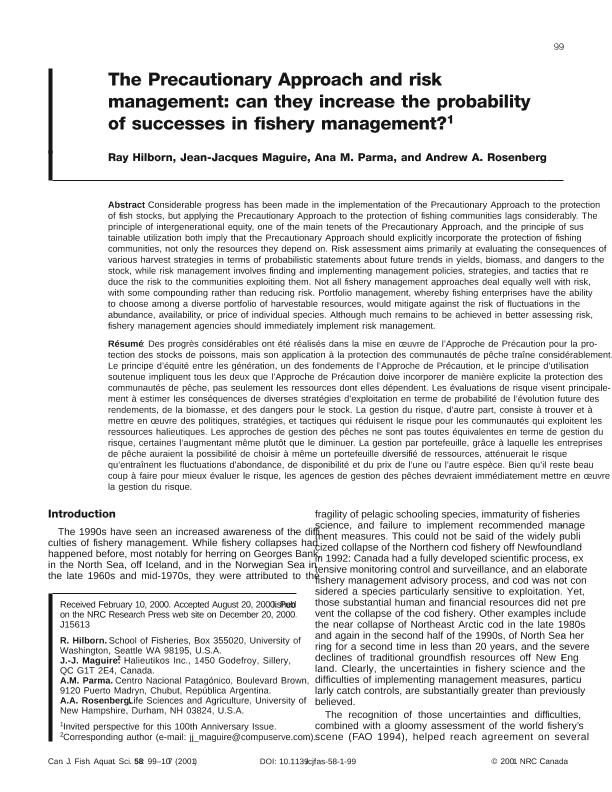Mostrar el registro sencillo del ítem
dc.contributor.author
Hilborn, Ray
dc.contributor.author
Maguire, Jean Jacques
dc.contributor.author
Parma, Ana María

dc.contributor.author
Rosenberg, Andrew
dc.date.available
2020-03-25T15:18:25Z
dc.date.issued
2001-12
dc.identifier.citation
Hilborn, Ray; Maguire, Jean Jacques; Parma, Ana María; Rosenberg, Andrew; The precautionary approach and risk management: Can they increase the probability of successes in fishery management?; National Research Council Canada-NRC Research Press; Canadian Journal Of Fisheries And Aquatic Sciences; 58; 1; 12-2001; 99-107
dc.identifier.issn
0706-652X
dc.identifier.uri
http://hdl.handle.net/11336/100687
dc.description.abstract
Considerable progress has been made in the implementation of the Precautionary Approach to the protection of fish stocks, but applying the Precautionary Approach to the protection of fishing communities lags considerably. The principle of intergenerational equity, one of the main tenets of the Precautionary Approach, and the principle of sustainable utilization both imply that the Precautionary Approach should explicitly incorporate the protection of fishing communities, not only the resources they depend on. Risk assessment aims primarily at evaluating the consequences of various harvest strategies in terms of probabilistic statements about future trends in yields, biomass, and dangers to the stock, while risk management involves finding and implementing management policies, strategies, and tactics that reduce the risk to the communities exploiting them. Not all fishery management approaches deal equally well with risk, with some compounding rather than reducing risk. Portfolio management, whereby fishing enterprises have the ability to choose among a diverse portfolio of harvestable resources, would mitigate against the risk of fluctuations in the abundance, availability, or price of individual species. Although much remains to be achieved in better assessing risk, fishery management agencies should immediately implement risk management.
dc.description.abstract
Des progrès considérables ont été réalisés dans la mise en œuvre de l’Approche de Précaution pour la protection des stocks de poissons, mais son application à la protection des communautés de pêche traîne considérablement. Le principe d’équité entre les génération, un des fondements de l’Approche de Précaution, et le principe d’utilisation soutenue impliquent tous les deux que l’Approche de Précaution doive incorporer de manière explicite la protection des communautés de pêche, pas seulement les ressources dont elles dépendent. Les évaluations de risque visent principalement à estimer les conséquences de diverses stratégies d’exploitation en terme de probabilité de l’évolution future des rendements, de la biomasse, et des dangers pour le stock. La gestion du risque, d’autre part, consiste à trouver et à mettre en œuvre des politiques, stratégies, et tactiques qui réduisent le risque pour les communautés qui exploitent les ressources halieutiques. Les approches de gestion des pêches ne sont pas toutes équivalentes en terme de gestion du risque, certaines l’augmentant même plutôt que le diminuer. La gestion par portefeuille, grâce à laquelle les entreprises de pêche auraient la possibilité de choisir à même un portefeuille diversifié de ressources, atténuerait le risque qu’entraînent les fluctuations d’abondance, de disponibilité et du prix de l’une ou l’autre espèce. Bien qu’il reste beaucoup à faire pour mieux évaluer le risque, les agences de gestion des pêches devraient immédiatement mettre en œuvre la gestion du risque.
dc.format
application/pdf
dc.language.iso
eng
dc.publisher
National Research Council Canada-NRC Research Press

dc.rights
info:eu-repo/semantics/openAccess
dc.rights.uri
https://creativecommons.org/licenses/by-nc-sa/2.5/ar/
dc.subject
PRECAUTIONARY APPROACH
dc.subject.classification
Ecología

dc.subject.classification
Ciencias Biológicas

dc.subject.classification
CIENCIAS NATURALES Y EXACTAS

dc.title
The precautionary approach and risk management: Can they increase the probability of successes in fishery management?
dc.type
info:eu-repo/semantics/article
dc.type
info:ar-repo/semantics/artículo
dc.type
info:eu-repo/semantics/publishedVersion
dc.date.updated
2020-02-11T17:57:02Z
dc.journal.volume
58
dc.journal.number
1
dc.journal.pagination
99-107
dc.journal.pais
Canadá

dc.journal.ciudad
Otawa
dc.description.fil
Fil: Hilborn, Ray. University of Washington; Estados Unidos
dc.description.fil
Fil: Maguire, Jean Jacques. Halieutikos; Canadá
dc.description.fil
Fil: Parma, Ana María. Consejo Nacional de Investigaciones Científicas y Técnicas. Centro Científico Tecnológico Conicet - Centro Nacional Patagónico; Argentina
dc.description.fil
Fil: Rosenberg, Andrew. University of New Hampshire; Estados Unidos
dc.journal.title
Canadian Journal Of Fisheries And Aquatic Sciences

dc.relation.alternativeid
info:eu-repo/semantics/altIdentifier/doi/http://dx.doi.org/10.1139/f00-225
dc.relation.alternativeid
info:eu-repo/semantics/altIdentifier/url/https://www.nrcresearchpress.com/doi/10.1139/f00-225#.Xnt1E-pKiM8
Archivos asociados
